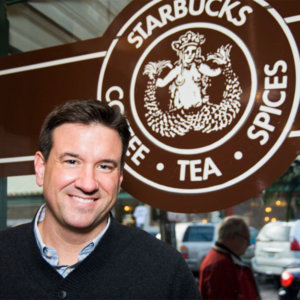How Starbucks Has Gone Digital
Two Starbucks executives — chief digital officer Adam Brotman and CIO Curt Garner — explain how they work closely together to deliver the giant coffee company’s customer-centered approach to technology.
Starbucks Coffee Company has become almost as well known for its free Wi-Fi as for its coffee. The $13.3 billion company provides a model of melding a physical retail operation with digital channels. It has more than 34 million Facebook likes and more than 3.6 million Twitter followers, and does well at using social media and mobile technology to build better relationships with its customers.
It is also in the vanguard of companies with a chief digital officer, having named Adam Brotman (@adambrotman) to that post in March 2012. Brotman, 43, had joined Starbucks in 2009 as vice president of digital ventures and now has a team of 110 under him. He works closely with Curt Garner, 43, a 15-year company veteran who became CIO in March 2012, running a department of 760.
Brotman and Garner spoke with MIT Sloan Management Review contributing editor Michael Fitzgerald about their relationship and how they’ve helped remake Starbucks into a digital company.
The two of you were promoted to CDO and CIO in March 2012. What have been your main projects since then?
Adam Brotman: We’ve made a lot of payment-related improvements to the customer experience — mobile payments, payments beyond our own app — and expanded that globally. We’ve made some changes to our loyalty system and loyalty programs, had a lot of technology work behind those changes, as well as customer-facing programmatic benefits and changes. We are working together on some internal employee portal improvements and changes; that’s a project that’s been high on the list. We’ve done loyalty card and mobile integration with some acquisitions that you’ve probably heard about, both on the tea side as well as on the fruit and juice side. We’ve continued to roll out our global Web and mobile platforms, generally. We’re in 62 [international] markets now, and not every single one of them has a global and mobile platform available to them, although we’re getting there.
Curt Garner: We currently have 100 projects active in IT, and 35 of them are customer- or partner-facing, including that portal project Adam talked about. As a high-growth company, we have a lot of opportunity to increase efficiency [and] productivity and create cost leverage across the organization.



Comment (1)
Christopher Rollyson